Linqi Song
REMA: A Unified Reasoning Manifold Framework for Interpreting Large Language Model
Sep 26, 2025Abstract:Understanding how Large Language Models (LLMs) perform complex reasoning and their failure mechanisms is a challenge in interpretability research. To provide a measurable geometric analysis perspective, we define the concept of the Reasoning Manifold, a latent low-dimensional geometric structure formed by the internal representations corresponding to all correctly reasoned generations. This structure can be conceptualized as the embodiment of the effective thinking paths that the model has learned to successfully solve a given task. Based on this concept, we build REMA, a framework that explains the origins of failures by quantitatively comparing the spatial relationships of internal model representations corresponding to both erroneous and correct reasoning samples. Specifically, REMA first quantifies the geometric deviation of each erroneous representation by calculating its k-nearest neighbors distance to the approximated manifold formed by correct representations, thereby providing a unified failure signal. It then localizes the divergence points where these deviations first become significant by tracking this deviation metric across the model's layers and comparing it against a baseline of internal fluctuations from correct representations, thus identifying where the reasoning chain begins to go off-track. Our extensive experiments on diverse language and multimodal models and tasks demonstrate the low-dimensional nature of the reasoning manifold and the high separability between erroneous and correct reasoning representations. The results also validate the effectiveness of the REMA framework in analyzing the origins of reasoning failures. This research connects abstract reasoning failures to measurable geometric deviations in representations, providing new avenues for in-depth understanding and diagnosis of the internal computational processes of black-box models.
KLIPA: A Knowledge Graph and LLM-Driven QA Framework for IP Analysis
Sep 09, 2025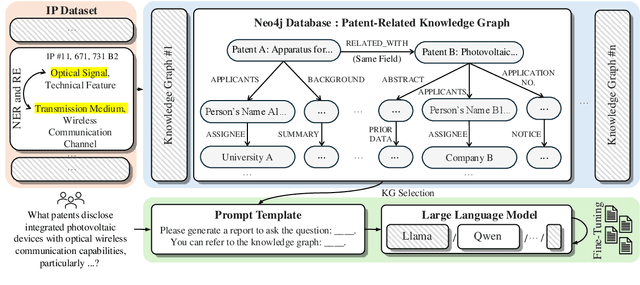
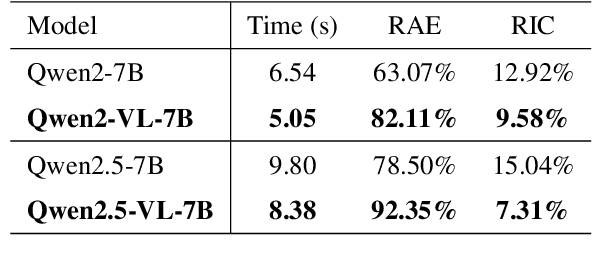
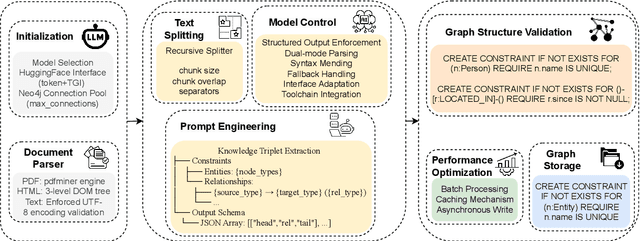
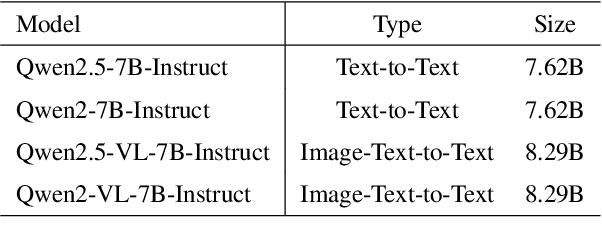
Abstract:Effectively managing intellectual property is a significant challenge. Traditional methods for patent analysis depend on labor-intensive manual searches and rigid keyword matching. These approaches are often inefficient and struggle to reveal the complex relationships hidden within large patent datasets, hindering strategic decision-making. To overcome these limitations, we introduce KLIPA, a novel framework that leverages a knowledge graph and a large language model (LLM) to significantly advance patent analysis. Our approach integrates three key components: a structured knowledge graph to map explicit relationships between patents, a retrieval-augmented generation(RAG) system to uncover contextual connections, and an intelligent agent that dynamically determines the optimal strategy for resolving user queries. We validated KLIPA on a comprehensive, real-world patent database, where it demonstrated substantial improvements in knowledge extraction, discovery of novel connections, and overall operational efficiency. This combination of technologies enhances retrieval accuracy, reduces reliance on domain experts, and provides a scalable, automated solution for any organization managing intellectual property, including technology corporations and legal firms, allowing them to better navigate the complexities of strategic innovation and competitive intelligence.
DrugMCTS: a drug repurposing framework combining multi-agent, RAG and Monte Carlo Tree Search
Jul 10, 2025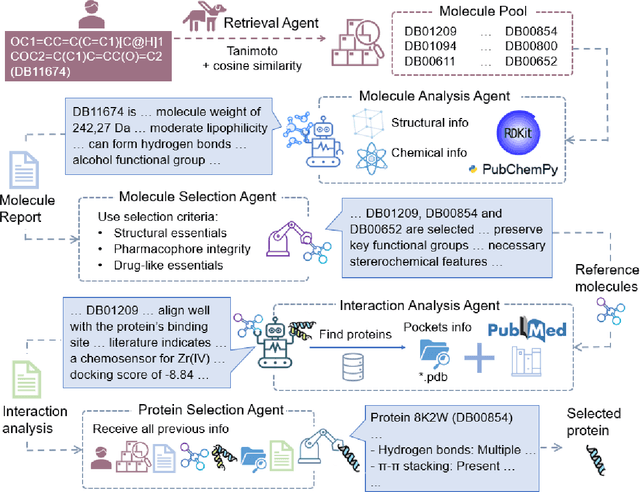
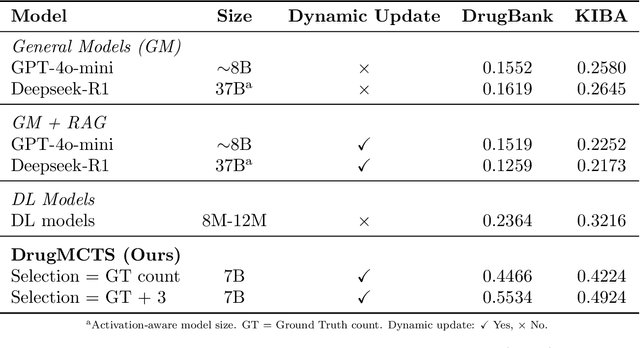

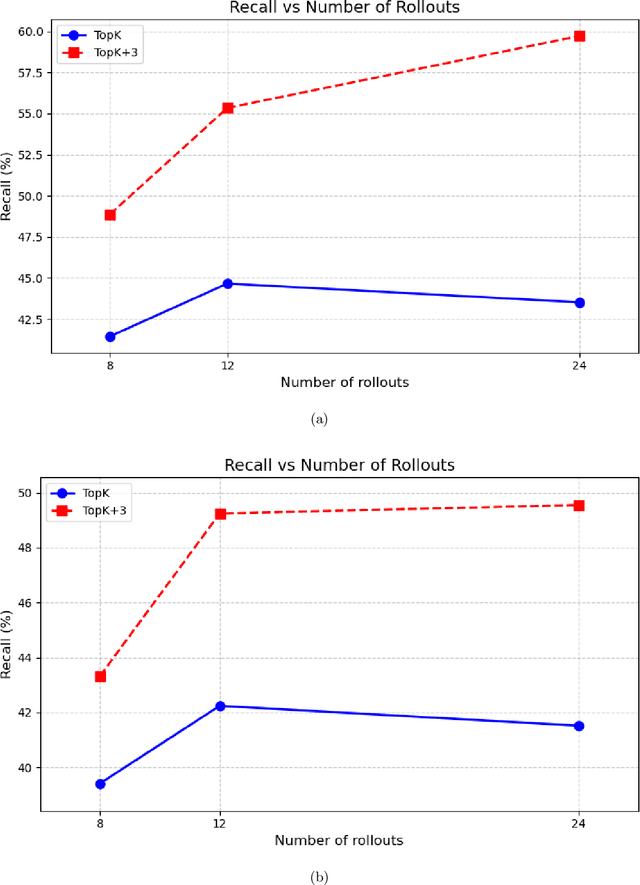
Abstract:Recent advances in large language models have demonstrated considerable potential in scientific domains such as drug discovery. However, their effectiveness remains constrained when reasoning extends beyond the knowledge acquired during pretraining. Conventional approaches, such as fine-tuning or retrieval-augmented generation, face limitations in either imposing high computational overhead or failing to fully exploit structured scientific data. To overcome these challenges, we propose DrugMCTS, a novel framework that synergistically integrates RAG, multi-agent collaboration, and Monte Carlo Tree Search for drug repurposing. The framework employs five specialized agents tasked with retrieving and analyzing molecular and protein information, thereby enabling structured and iterative reasoning. Without requiring domain-specific fine-tuning, DrugMCTS empowers Qwen2.5-7B-Instruct to outperform Deepseek-R1 by over 20\%. Extensive experiments on the DrugBank and KIBA datasets demonstrate that DrugMCTS achieves substantially higher recall and robustness compared to both general-purpose LLMs and deep learning baselines. Our results highlight the importance of structured reasoning, agent-based collaboration, and feedback-driven search mechanisms in advancing LLM applications for drug discovery.
What Makes a Good Reasoning Chain? Uncovering Structural Patterns in Long Chain-of-Thought Reasoning
May 28, 2025



Abstract:Recent advances in reasoning with large language models (LLMs) have popularized Long Chain-of-Thought (LCoT), a strategy that encourages deliberate and step-by-step reasoning before producing a final answer. While LCoTs have enabled expert-level performance in complex tasks, how the internal structures of their reasoning chains drive, or even predict, the correctness of final answers remains a critical yet underexplored question. In this work, we present LCoT2Tree, an automated framework that converts sequential LCoTs into hierarchical tree structures and thus enables deeper structural analysis of LLM reasoning. Using graph neural networks (GNNs), we reveal that structural patterns extracted by LCoT2Tree, including exploration, backtracking, and verification, serve as stronger predictors of final performance across a wide range of tasks and models. Leveraging an explainability technique, we further identify critical thought patterns such as over-branching that account for failures. Beyond diagnostic insights, the structural patterns by LCoT2Tree support practical applications, including improving Best-of-N decoding effectiveness. Overall, our results underscore the critical role of internal structures of reasoning chains, positioning LCoT2Tree as a powerful tool for diagnosing, interpreting, and improving reasoning in LLMs.
Reasoning Meets Personalization: Unleashing the Potential of Large Reasoning Model for Personalized Generation
May 23, 2025Abstract:Personalization is a critical task in modern intelligent systems, with applications spanning diverse domains, including interactions with large language models (LLMs). Recent advances in reasoning capabilities have significantly enhanced LLMs, enabling unprecedented performance in tasks such as mathematics and coding. However, their potential for personalization tasks remains underexplored. In this paper, we present the first systematic evaluation of large reasoning models (LRMs) for personalization tasks. Surprisingly, despite generating more tokens, LRMs do not consistently outperform general-purpose LLMs, especially in retrieval-intensive scenarios where their advantages diminish. Our analysis identifies three key limitations: divergent thinking, misalignment of response formats, and ineffective use of retrieved information. To address these challenges, we propose Reinforced Reasoning for Personalization (\model), a novel framework that incorporates a hierarchical reasoning thought template to guide LRMs in generating structured outputs. Additionally, we introduce a reasoning process intervention method to enforce adherence to designed reasoning patterns, enhancing alignment. We also propose a cross-referencing mechanism to ensure consistency. Extensive experiments demonstrate that our approach significantly outperforms existing techniques.
Activation-Guided Consensus Merging for Large Language Models
May 20, 2025Abstract:Recent research has increasingly focused on reconciling the reasoning capabilities of System 2 with the efficiency of System 1. While existing training-based and prompt-based approaches face significant challenges in terms of efficiency and stability, model merging emerges as a promising strategy to integrate the diverse capabilities of different Large Language Models (LLMs) into a unified model. However, conventional model merging methods often assume uniform importance across layers, overlooking the functional heterogeneity inherent in neural components. To address this limitation, we propose \textbf{A}ctivation-Guided \textbf{C}onsensus \textbf{M}erging (\textbf{ACM}), a plug-and-play merging framework that determines layer-specific merging coefficients based on mutual information between activations of pre-trained and fine-tuned models. ACM effectively preserves task-specific capabilities without requiring gradient computations or additional training. Extensive experiments on Long-to-Short (L2S) and general merging tasks demonstrate that ACM consistently outperforms all baseline methods. For instance, in the case of Qwen-7B models, TIES-Merging equipped with ACM achieves a \textbf{55.3\%} reduction in response length while simultaneously improving reasoning accuracy by \textbf{1.3} points. We submit the code with the paper for reproducibility, and it will be publicly available.
RALLRec+: Retrieval Augmented Large Language Model Recommendation with Reasoning
Mar 26, 2025Abstract:Large Language Models (LLMs) have been integrated into recommender systems to enhance user behavior comprehension. The Retrieval Augmented Generation (RAG) technique is further incorporated into these systems to retrieve more relevant items and improve system performance. However, existing RAG methods have two shortcomings. \textit{(i)} In the \textit{retrieval} stage, they rely primarily on textual semantics and often fail to incorporate the most relevant items, thus constraining system effectiveness. \textit{(ii)} In the \textit{generation} stage, they lack explicit chain-of-thought reasoning, further limiting their potential. In this paper, we propose Representation learning and \textbf{R}easoning empowered retrieval-\textbf{A}ugmented \textbf{L}arge \textbf{L}anguage model \textbf{Rec}ommendation (RALLRec+). Specifically, for the retrieval stage, we prompt LLMs to generate detailed item descriptions and perform joint representation learning, combining textual and collaborative signals extracted from the LLM and recommendation models, respectively. To account for the time-varying nature of user interests, we propose a simple yet effective reranking method to capture preference dynamics. For the generation phase, we first evaluate reasoning LLMs on recommendation tasks, uncovering valuable insights. Then we introduce knowledge-injected prompting and consistency-based merging approach to integrate reasoning LLMs with general-purpose LLMs, enhancing overall performance. Extensive experiments on three real world datasets validate our method's effectiveness.
Sens-Merging: Sensitivity-Guided Parameter Balancing for Merging Large Language Models
Feb 19, 2025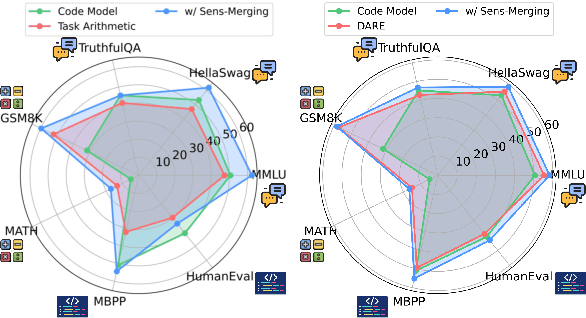

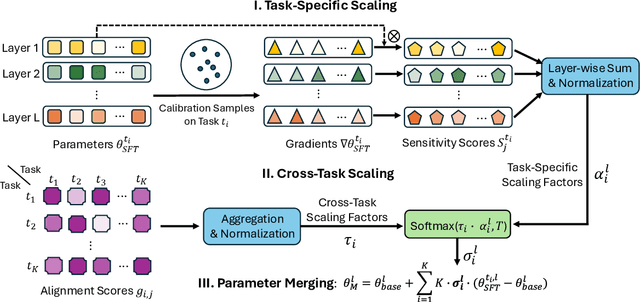

Abstract:Recent advances in large language models have led to numerous task-specialized fine-tuned variants, creating a need for efficient model merging techniques that preserve specialized capabilities while avoiding costly retraining. While existing task vector-based merging methods show promise, they typically apply uniform coefficients across all parameters, overlooking varying parameter importance both within and across tasks. We present Sens-Merging, a sensitivity-guided coefficient adjustment method that enhances existing model merging techniques by operating at both task-specific and cross-task levels. Our method analyzes parameter sensitivity within individual tasks and evaluates cross-task transferability to determine optimal merging coefficients. Extensive experiments on Mistral 7B and LLaMA2-7B/13B models demonstrate that Sens-Merging significantly improves performance across general knowledge, mathematical reasoning, and code generation tasks. Notably, when combined with existing merging techniques, our method enables merged models to outperform specialized fine-tuned models, particularly in code generation tasks. Our findings reveal important trade-offs between task-specific and cross-task scalings, providing insights for future model merging strategies.
RALLRec: Improving Retrieval Augmented Large Language Model Recommendation with Representation Learning
Feb 10, 2025Abstract:Large Language Models (LLMs) have been integrated into recommendation systems to enhance user behavior comprehension. The Retrieval Augmented Generation (RAG) technique is further incorporated into these systems to retrieve more relevant items and improve system performance. However, existing RAG methods rely primarily on textual semantics and often fail to incorporate the most relevant items, limiting the effectiveness of the systems. In this paper, we propose Representation learning for retrieval-Augmented Large Language model Recommendation (RALLRec). Specifically, we enhance textual semantics by prompting LLMs to generate more detailed item descriptions, followed by joint representation learning of textual and collaborative semantics, which are extracted by the LLM and recommendation models, respectively. Considering the potential time-varying characteristics of user interest, a simple yet effective reranking method is further introduced to capture the dynamics of user preference. We conducted extensive experiments on three real-world datasets, and the evaluation results validated the effectiveness of our method. Code is made public at https://github.com/JianXu95/RALLRec.
Communication-Efficient and Privacy-Adaptable Mechanism for Federated Learning
Jan 21, 2025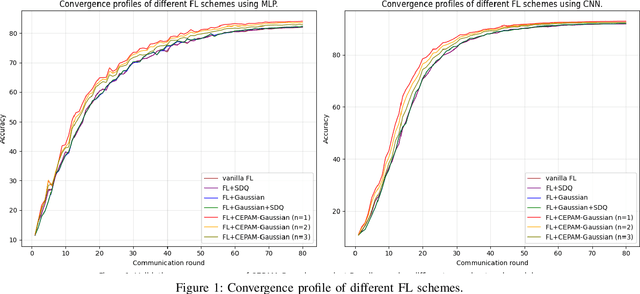
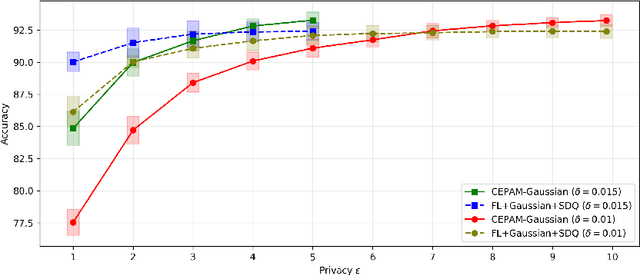
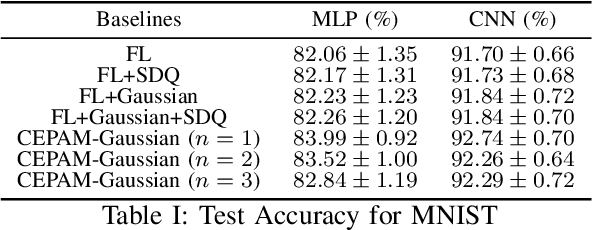
Abstract:Training machine learning models on decentralized private data via federated learning (FL) poses two key challenges: communication efficiency and privacy protection. In this work, we address these challenges within the trusted aggregator model by introducing a novel approach called the Communication-Efficient and Privacy-Adaptable Mechanism (CEPAM), achieving both objectives simultaneously. In particular, CEPAM leverages the rejection-sampled universal quantizer (RSUQ), a construction of randomized vector quantizer whose resulting distortion is equivalent to a prescribed noise, such as Gaussian or Laplace noise, enabling joint differential privacy and compression. Moreover, we analyze the trade-offs among user privacy, global utility, and transmission rate of CEPAM by defining appropriate metrics for FL with differential privacy and compression. Our CEPAM provides the additional benefit of privacy adaptability, allowing clients and the server to customize privacy protection based on required accuracy and protection. We assess CEPAM's utility performance using MNIST dataset, demonstrating that CEPAM surpasses baseline models in terms of learning accuracy.
 Add to Chrome
Add to Chrome Add to Firefox
Add to Firefox Add to Edge
Add to Edge